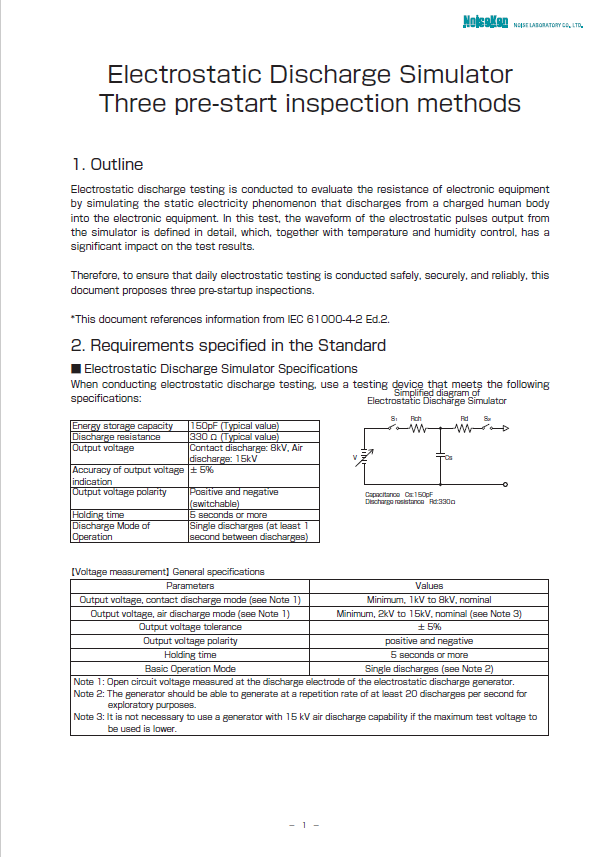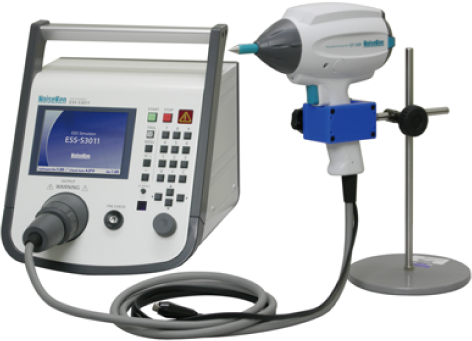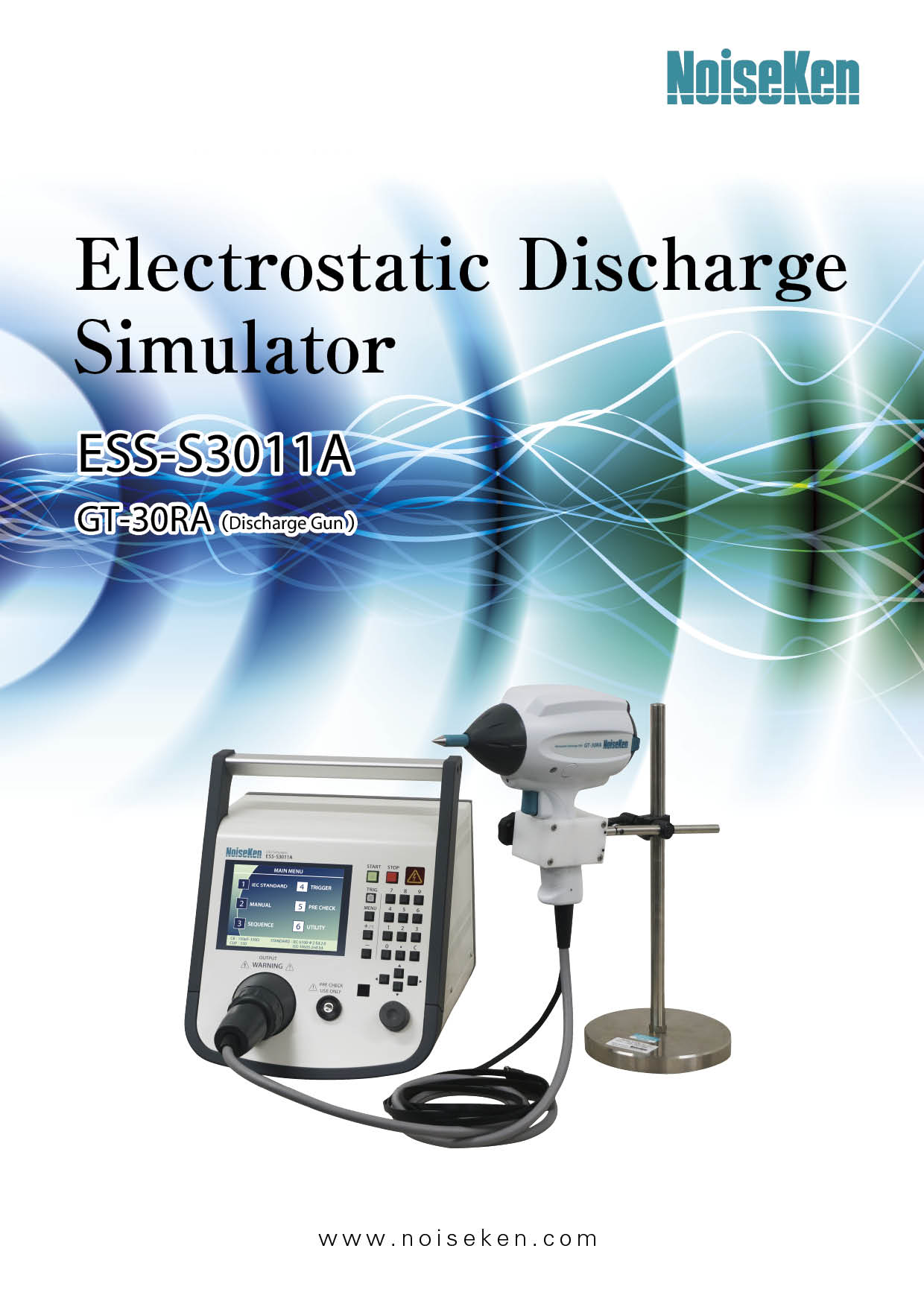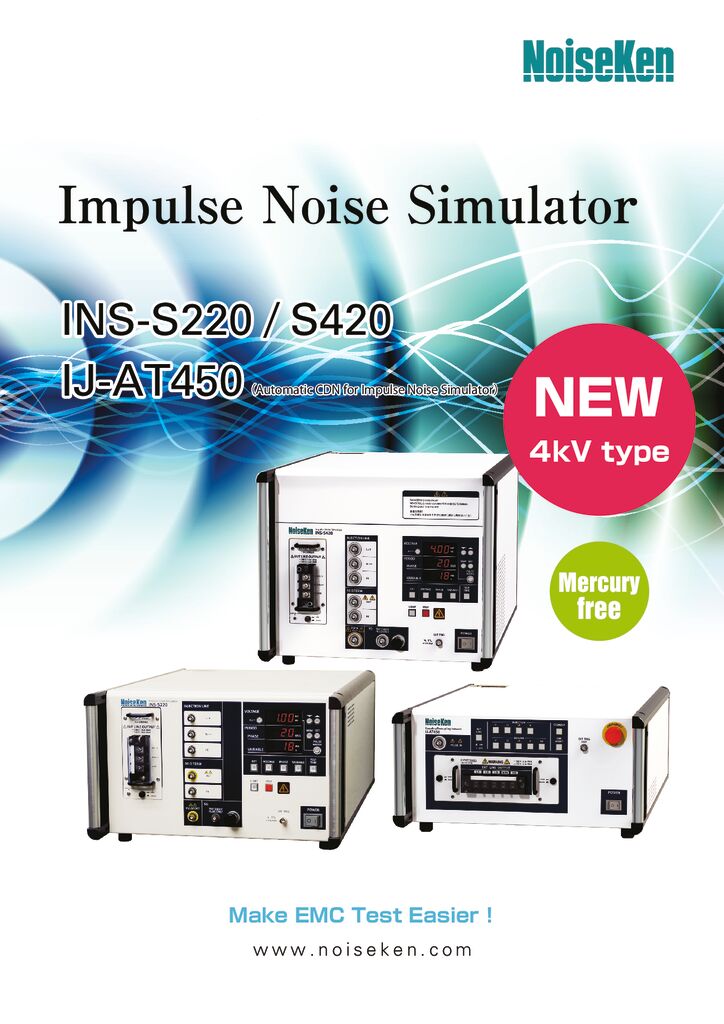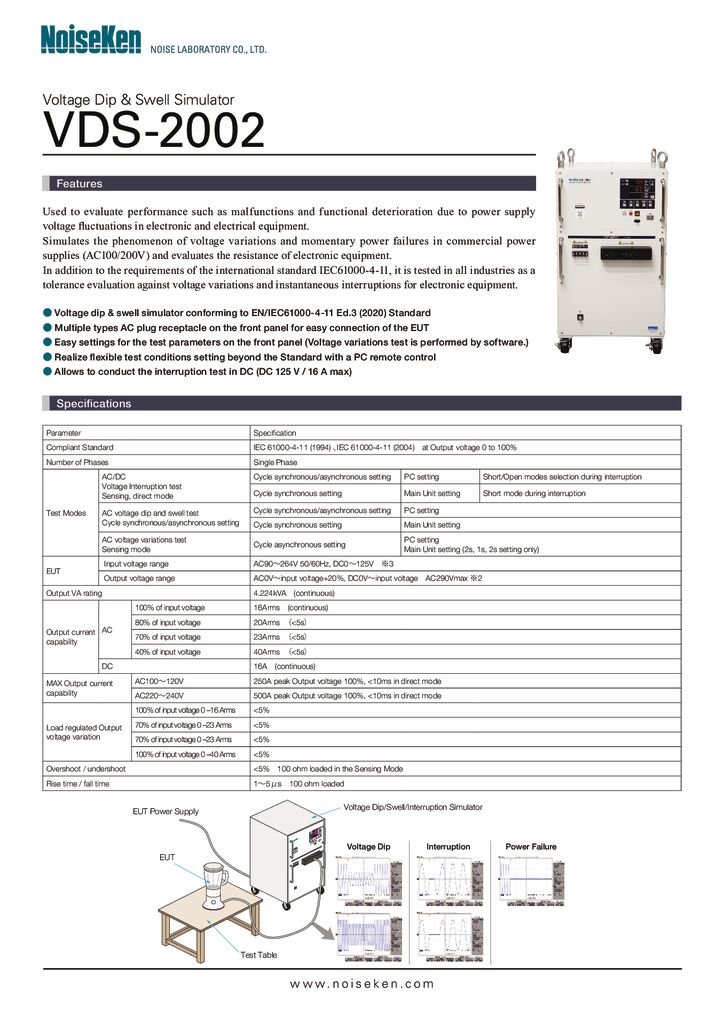Product Information Electrostatic Discharge Simulator Three pre-start inspection methods
NoiseKen1. Outline
Electrostatic discharge testing is conducted to evaluate the resistance of electronic equipment by simulating the static electricity phenomenon that discharges from a charged human body into the electronic equipment. In this test, the waveform of the electrostatic pulses output from the simulator is defined in detail, which, together with temperature and humidity control, has a significant impact on the test results.
Therefore, to ensure that daily electrostatic testing is conducted safely, securely, and reliably, this document proposes three pre-startup inspections.
*This page references information from IEC 61000-4-2 Ed.2.
2. Requirements specified in the Standard
■Electrostatic Discharge Simulator Specifications
When conducting electrostatic discharge testing, use a testing device that meets the following specifications:
| Energy storage capacity | 150pF (Typical value) |
| Discharge resistance | 330Ω (Typical value) |
| Output voltage | Contact discharge: 8kV, Air discharge: 15kV |
| Accuracy of output voltage indication | ±5% |
| Output voltage polarity | Positive and negative (switchable) |
| Holding time | 5 seconds or more |
| Discharge Mode of Operation | Single discharges (at least 1 second between discharges) |
Simplified diagram of Electrostatic Discharge Simulator

【Voltage measurement】 General specifications
| Parameters | Values |
| Output voltage, contact discharge mode (see Note 1) | Minimum, 1kV to 8kV, nominal |
| Output voltage, air discharge mode (see Note 1) | Minimum, 2kV to 15kV, nominal (see Note 3) |
| Output voltage tolerance | ±5% |
| Output voltage polarity | positive and negative |
| Holding time | 5 seconds or more |
| Basic Operation Mode | Single discharges (see Note 2) |
| Note 1: Open circuit voltage measured at the discharge electrode of the electrostatic discharge generator. Note 2: The generator should be able to generate at a repetition rate of at least 20 discharges per second forexploratory purposes. Note 3: It is not necessary to use a generator with 15 kV air discharge capability if the maximum test voltage tobe used is lower. | |
【Current measurement】 Contact discharge current waveform parameters
| Level | IndicatedVoltage | First peakcurrent of discharge±15% | Rise time(±25%) | Currentat 60 ns(±30%) | Currentat 60 ns(±30%) |
| 1 | 2kV | 7.5A | 0.8ns | 4A | 2A |
| 2 | 4kV | 15A | 0.8ns | 8A | 4A |
| 3 | 6kV | 22.5A | 0.8ns | 12A | 6A |
| 4 | 8kV | 30A | 0.8ns | 16A | 8A |
| The reference point for measuring the time for the current at 30 ns and 60 ns is the instant when the current first reaches 10 % of the 1st peak of the discharge current.Note: The rise time is the time interval between 10 % and 90 % value of 1st peakcurrent. | |||||
Discharge current waveform and waveform characteristics

3. Preparation of the Test Generator
It is important to keep the test environment and the main body of the testing equipment in correct condition when conducting electrostatic tests, not only in the pre-start inspection.
Please refer to the following information to ensure that your daily testing is safe, secure and reliable.
●Temperature and humidity control
Electrostatic testing is very strongly affected by temperature and humidity. The testing environment should be within the following temperature and humidity ranges.
IEC 61000-4-2 Ed.2 defines the range of ambient temperature/relative humidity for air discharge testing.
・Ambient temperature: 15°C to 35°C
・Relative humidity: 30% to 60%
At the lower (15°C/30%) and upper (35°C/60%) limits of ambient temperature/relative humidity specified in IEC 61000-4-2 Ed.2, the difference in absolute humidity is about six times greater.
If the absolute humidity is high, the discharge will be over a long distance, the peak current value will be low and the rise of the current waveform will slow down, this may be a relatively lenient test with few high frequency components.
Also, the reproducibility of the test would be poor due to the long discharge distance.
Therefore, for air discharge it is recommended to conduct the testing in an environment with absolute humidity as low as possible.
●Cleaning of the discharge gun
Clean the discharge gun using the following items. It is recommended to conduct the cleaning before start of the testing.
・Anhydrous alcohol (anhydrous ethanol): Ethanol 99/5 vol% or more
・Wipes: Unsoiled and free of paper dust or fiber residue (disposable paper wads are recommended)
(Cleaning method)
Wipe the cleaning area lightly with a wipe moistened with a little anhydrous alcohol.
If the surface of the discharge gun becomes contaminated, the surface resistance will be low, and if the contamination is hygroscopic, it will be easily affected by humidity, which may result in unstable and non-reproducible tests.
On the other hand, when the surface is clean, the surface resistance is high and there is no
copic contamination The test is less susceptible to the effects of humidity, and is stable and reproducible.
4. Three pre-start inspection methods
We offer the following three methods of pre-start inspection.
(1) ESD Simulator pre-check functions
(2) Voltage measurement using ESD voltage meter
(3) Current waveform observation (ESD current target, oscilloscope, etc.)
■ Comparison of three pre-start inspection methods
(1) ESD Simulator pre-check
functions


(2) Voltage measurement using ESD voltage meter

Current waveform observation
(ESD current target, oscilloscope, etc.)

Inspection method | (1) ESD Simulator pre-check functions | (2) Voltage measurement usingESD voltage meter | Current waveform observation (ESD current target, oscilloscope, etc.) | |
| Voltage measurement | Output voltage | ー | 〇 | ー |
| Holding time | ー | ◎ | ー | |
| Current waveform | ー | ー | ◎ | |
| Failure Diagnostics | 〇 | 〇 | 〇 | |
◎: Standard Compliant 〇: Simple -: Not available
(1) ESD Simulator pre-check functions
● Outline
2-step check function of the ESD Simulator main unit.
STEP1. Check for high-voltage power output and insulation defects
STEP2. Operation check of discharge relay of discharge gun
●Equipped models
ESS-PS1 & GT-31S

ESS-S3011A & GT-30RA

●Advantages and disadvantages
| Advantages ・Simple, because the pre-check is conducted by the generator itself. ・Easy for daily failure diagnostics ・Can be conducted without any specializedknowledge | Disadvantages ・Not in accordance with the Standard |
(2) Voltage measurement using ESD voltage meter MODEL: 18-00086B
● Outline
Easily measures the Holding Time of air discharge test,
which is a specification of the tester required by the standard.
Capable of measuring the output voltage from ±2kV to ±30kV
●Requirements of the Standard
Output voltage and holding time specified in IEC 61000-4-2 Ed.2 Standard.
Contact discharge mode: (minimum) 1kV to 8kV (±5%)
Air discharge mode: (minimum) 2kV to 15kV (±5%) Holding Time: 5 seconds or more

● Advantages/Disadvantages
| Advantages ・Easy measurement of air-discharge HoldingTime (compliant with the Standard) ・Simple operation and accurate measurement ・No special knowledge or skills required | Disadvantages ・Current waveforms cannot be measured ・Voltage measurement is not compliant to theStandard due to a different accuracy tolerance. |
●Measurement procedure

(3) Current waveform measurement
● Outline
The current waveform of the electrostatic tester is observed using
a Faraday cage (target mounting plate), ESD current target and an
oscilloscope with a frequency bandwidth of 2 GHz or more.
・Discharge tip (conical) at the tip of the discharge gun is put
in contact directly with the current target and the electrostatic
tester operates in contact discharge mode
・Three variation types can be offered, from manufacturer’s
calibration level to simple pre-check package.

●Requirements of the Standard
| Level | IndicatedVoltage | First peakcurrent of discharge±15% | Rise time(±25%) | Currentat 60 ns(±30%) | Currentat 60 ns(±30%) |
| 1 | 2kV | 7.5A | 0.8ns | 4A | 2A |
| 2 | 4kV | 15A | 0.8ns | 8A | 4A |
| 3 | 6kV | 22.5A | 0.8ns | 12A | 6A |
| 4 | 8kV | 30A | 0.8ns | 16A | 8A |

●Advantages and disadvantages
| Advantages ・Accurate measurement of current waveforms compliant with the Standard (level equivalent to calibration) ・Three variations to choose from, from simplified to Standard-compliant | Disadvantages ・Takes a lot of time and effort to set up ・Requires specialized skills in the operation of measuring equipment ・Simplified version reduces reproducibility of waveform observation |
●Three variations
1. International standard compliant package
●Items
Faraday cage: FC-200
ESD current target: 06-00094A*
BNC-SMA conversion connector: 02-00133A
Ground cable holding stand: 03-00060A
Discharge gun mount: 03-00061B
*Includes Coaxial cable: 02-00157A and
20dB BNC type attenuator: 00-00022A.

●Advantages and disadvantages
| Advantages ・Highly accurate waveform observation incompliance with international Standard. | Disadvantages ・Equipment is large in size and expensive. |
2.Simplified version
●Items
Target mounting board: 03-00052B
ESD current target: 06-00094A*
BNC-SMA conversion connector: 02-00133A
Ground cable positioner: 03-00060A
Discharge gun mount: 03-00061B
*Includes Coaxial cable: 02-00157A and
20dB BNC type attenuator: 00-00022A.

●Advantages and disadvantages
| Advantages ・Highly accurate current waveform observation despite being a simplified version ・The large size of the target mounting board makes it difficult for radiation noise from the discharge gun to affect the oscilloscope. ・In some cases, it can be said to becompliant with the Standard. * | Disadvantages ・In some cases may be not compliant to theStandard. * ・The size of the equipment is large. |
*IEC 61000-4-2 Annex D.5 states that “measurements should be carried out in a shielded room
(not necessary if the environment does not produce significant interference).
3. Easy version
●Items
Target mounting board: 03-00027A
ESD current target: 06-00094A*
BNC-SMA conversion connector: 02-00133A
*Includes Coaxial cable: 02-00157A and
20dB BNC type attenuator: 00-00022A.

●Advantages and disadvantages
| Advantages ・Space-saving and inexpensive ・Easy to set up and carry out themeasurement | Disadvantages ・Not in accordance with the Standard. ・The discharge gun must be held by hand. ・The small size of the target mounting board makes the oscilloscope susceptible to radiation noise from the discharge gun. ・The waveform is highly variable and poorly reproducible. |

